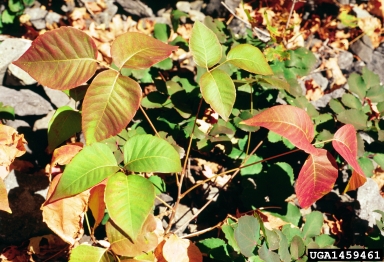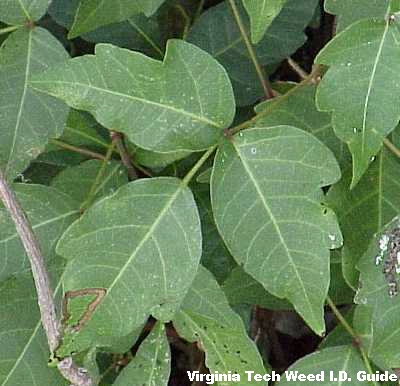Leaves of Three, Let It Be
By Doug Coffey, former Fairfax Master Gardener
 My neighbor, an Iranian immigrant, decided to remove a large bush maybe 4 to 5 feet tall and nearly as wide between our properties. I had ignored it, knowing it was so covered in poison ivy that the original plant was unrecognizable. I decided it was better to leave the “bush” alone until I could figure out how to get rid of it. But my neighbor, not consulting with me and not knowing the risks, got out a shovel, dug it up, pulled it out, cut it into pieces and hauled it to the curb. Within hours, he was in the emergency room and then several days after in the hospital getting massive doses of steroids. He was so uncomfortable with the extensive blistering, rash and itching that he couldn’t even find a way to sleep. Even thinking about it today makes my skin itch.
My neighbor, an Iranian immigrant, decided to remove a large bush maybe 4 to 5 feet tall and nearly as wide between our properties. I had ignored it, knowing it was so covered in poison ivy that the original plant was unrecognizable. I decided it was better to leave the “bush” alone until I could figure out how to get rid of it. But my neighbor, not consulting with me and not knowing the risks, got out a shovel, dug it up, pulled it out, cut it into pieces and hauled it to the curb. Within hours, he was in the emergency room and then several days after in the hospital getting massive doses of steroids. He was so uncomfortable with the extensive blistering, rash and itching that he couldn’t even find a way to sleep. Even thinking about it today makes my skin itch.
Poison ivy (Toxicodendron radicans) contains a lacquer-type oil called urushiol, (you-Roo-shee-all) that can cause redness, swelling and blisters.
Urushiol is found in all parts of the plant — the leaves, stems and even the roots, and is part of the plant’s defense against browsing animals and human beings who try to remove it. The oil is mostly colorless to watery yellow and has no odor. It is secreted from any damaged part of the plant. Urushiol fools the body into thinking there is something foreign in the body and causes a violent immune system response.Urushiol can contaminate clothing, tools, pet fur or other objects and effectiveness can persist up to five years. It is such a strong toxin that ¼ ounce would be enough to give every human on earth a rash. Some people are severely affected and will get pain and weeping blisters from skin contact. Other sufferers may just have mild itching and redness.
Within minutes of contact with the oil, the skin starts to absorb it. But you don’t feel it and don’t see a rash right away. Once urushiol has penetrated into the skin, attempting to remove it with water is ineffective. But it is worth noting that you cannot give the rash to someone else. Even if the person touches your rash or the fluids in your blisters, the person cannot get the rash. The person has to come into contact with the oil. It usually spreads from unwashed clothes, bedding, tools, pets or fingernails where there is still plant oil.
For people who have never been exposed or are not yet allergic to urushiol, it may take 10 to 21 days for a reaction to occur the first time. Once allergic to urushiol, however, most people break out 48 to 72 hours after contact with the oil. Typically, individuals have been exposed at least once, if not several times, before they develop a rash. The rash typically persists one to two weeks, but in some cases may last up to five weeks.
The rash itself is not contagious and does not spread. It might seem to spread, but is really a delayed reaction. The rash takes one to two weeks to run its course and in severe exposure cases, may cause scars. Severe cases involve small (1–2 mm), clear, fluid-filled blisters on the skin. Pus-filled vesicles containing a whitish fluid may indicate an infection. Excessive scratching may result in an infection that requires antibiotics.

Poison ivy fall color
People vary greatly in their sensitivity to urushiol but approximately 80 percent to 90 percent of adults will commonly get a rash if they are exposed to even a small amount of the oil. In terms of health emergencies, poison ivy leads the vegetative world, accounting for the most doctor and emergency room visits each year.
Primary treatment involves washing exposed skin thoroughly with soap, cool water and friction as soon as possible after exposure is discovered. Before the urushiol has been absorbed by the skin, it can be removed by washing the exposed area with cool water. However, time is of the essence, as 50 percent of the urushiol can be absorbed within 10 minutes. Soap or detergent is necessary because urushiol is an oil; friction, with a washcloth or something similar, is necessary because urushiol adheres strongly to the skin. There are commercial removal preparations available, but the key is to wash all exposed skin.
If you don’t get the oil off and a rash develops, the U.S. Food and Drug Administration recommends applying a wet compress or soaking the affected area in cool water; topical corticosteroids (available over-the-counter) or oral corticosteroids (available by prescription); and topical skin protectants, such as zinc acetate, zinc carbonate, zinc oxide and calamine. Baking soda or colloidal oatmeal can relieve minor irritation and itching. Aluminum acetate, sometimes known as Burow’s solution, can also ease the rash.

Climbing poison ivy
Poison ivy belongs to the same plant family as the cashew (Anacardiaceae). The plants grow as creeping vines, climbing vines, even shrubs. It reproduces both by creeping rootstocks and by seeds. Appearance varies. Leaves may be shiny or dull, arranged in an alternate pattern, usually in groups of three, from 20 to 50 mm long, pointed at the tip, and may be toothed, smooth or lobed, but never serrated. Leaves are reddish in spring, green in summer, and yellow, orange or red in fall. The plant may have greenish-white flowers and whitish-yellow berries. Vines grow almost straight up rather than wrapping around their support, and can grow to 8 to 10 m in height. In some cases, poison ivy may entirely engulf the supporting structure, and vines may extend outward like limbs, so that it appears to be a poison ivy “tree.”

Leaves can be toothed
Regardless of how it is growing, poison ivy is distinguished by leaves on petioles that are divided into three leaflets that are generally oval in outline. Leaflets may be either toothed, untoothed or lobed. The two lateral leaflets occur on very short petioles, while the central leaflet occurs on a much longer petiole. Although leaf shape is highly variable, the lateral leaflets are often distinctly lobed on one side of the leaflet and not on the other. Each leaflet is hairless and ranges from 3/4 to 4 inches in length and width.
Poison ivy is more common now than when Europeans first arrived in North America. The development of real estate adjacent to undeveloped land has enabled poison ivy to form vast, lush colonies in the areas between developed and undeveloped lands.
A study by researchers at the University of Georgia found that poison ivy is particularly sensitive to carbon dioxide levels, greatly benefiting from higher concentrations in the atmosphere. Poison ivy’s growth and potency has already doubled since the 1960s.
Surveys of forest plants in South Carolina by Jacqueline Mohan, an assistant professor of biology at the University of Georgia, showed poison ivy to be one of only a few plants to be increasing in abundance in coastal plain forests. Lewis H. Ziska, a research weed ecologist with the U.S. Department of Agriculture, said laboratory and field studies show that poison ivy is advancing with climate change. That trend will continue as carbon dioxide levels keep rising. It is more and more likely that if you garden, you will come across “leaves of three,” so follow the advice to let it be. Or be careful in removing it.
Trivia quiz: What do mango trees, cashew and poison ivy have in common?
ANSWER: They all belong to the same family, Anacardiaceae, and contain the oil urushiol.
References
• Poison Ivy: Leaves of Three? Let it Be, Publication 426-109, Virginia Cooperative Extension
• Getting to Know Poison Ivy, Fairfax County Master Gardeners
• Poison Ivy, VA Tech Department of Forest Resources and Environmental Conservation
• Poison Ivy (blog)
• Poison Ivy, Oak and Sumac, American Academy of Dermatology
• Poison Ivy: The Most Common of Allergens, Ray Thomas MD, Professor Emeritus of Dermatology,
University of Iowa Health Care
… updated 2022